Commercial Air Conditioning System Market Research, 2031
The global commercial air conditioning system market was valued at $38.3 billion in 2021, and is projected to reach $57.9 billion by 2031, growing at a CAGR of 4.5% from 2022 to 2031. A large-scale refrigeration and dehumidification system referred to as a commercial air conditioning system is used to cool and control the temperature and humidity levels of commercial or industrial buildings, including offices, hospitals, hotels, schools, factories, and other sizable places. To cool, filter, and circulate air throughout the building, these systems employ cutting-edge technology, giving building inhabitants a comfortable and healthy interior environment.
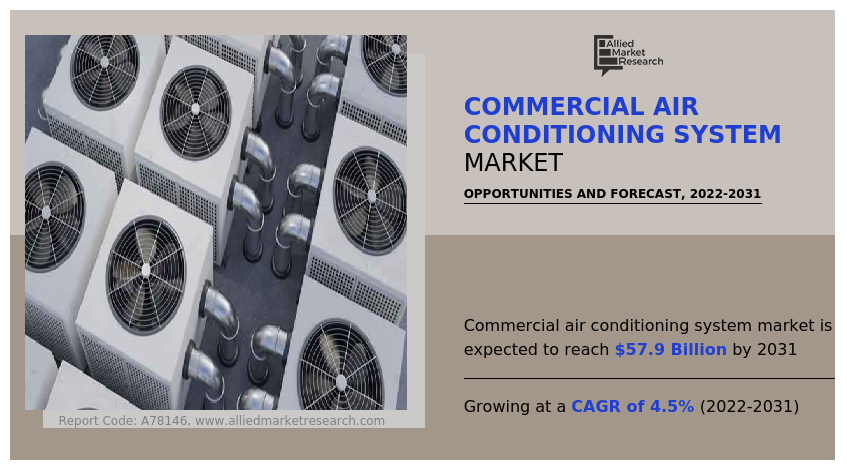
The demand for commercial air conditioning systems is being heavily influenced by the increasing awareness of indoor air quality. There is a rising need for air conditioning systems that provide clean, fresh air as people become more conscious of the health and comfort advantages of high indoor air quality. Given that many people spend a lot of time indoors in places such as hospitals, businesses, and schools, this trend is particularly relevant for commercial buildings. Because they can help in removing pollutants, allergens, and hazardous particles from indoor air, sophisticated filtration technology, UV radiation, and other air purification techniques are in high demand for air conditioning systems. These systems help reduce the transmission of airborne infections in addition to improving the health and comfort of building inhabitants. Manufacturers of commercial air conditioning systems are consequently concentrating on creating cutting-edge technologies and solutions to satisfy the expanding demand for high-quality indoor air. The market for commercial air conditioning system market opportunities is expected to grow in the upcoming year.
The commercial air conditioning system industry is hindered by high installation and maintenance costs. Commercial air conditioning systems may be costly to buy, install, and maintain initially. High expenses might make purchasing an air conditioning system challenging for enterprises on a limited budget. A burdensome expense for firms that are already battling to survive is maintenance fees. However, it should be remembered that over time, a commercial air conditioning system could prove to be advantageous. For example, a well-maintained air conditioning system can improve employee productivity, customer satisfaction, and even help reduce the risk of equipment failure due to overheating.
The demand for energy saving, environmentally friendly, and cutting-edge solutions has prompted the continuous growth and evolution of the commercial air conditioning system market. Companies now have the chance to set themselves apart by creating goods that offer higher energy efficiency, reduced running costs, and improved indoor air quality because of the development of new technologies such nanotechnology, advanced refrigerants, AI, and IoT. For instance, the size and weight of commercial air conditioning systems may be decreased by using extremely efficient and small heat exchangers made of nanotechnology. Advanced refrigerants can greatly increase these systems' energy efficiency while lowering their running costs and environmental effect. Additionally, remote monitoring and control, proactive maintenance, and automatic system performance optimization can all be made possible by commercial air conditioning systems' incorporation of AI and IoT technology. This may result in less energy being used, better air quality inside the building, and greater occupant comfort and productivity.
The key players profiled in this report include Carrier.; DAIKIN INDUSTRIES, Ltd; FUJITSU GENERAL; Haier Inc; Hitachi, Ltd.; LG Electronics.; Mitsubishi Electric Corporation; Panasonic Corporation; SAMSUNG; and AIREDALE INTERNATIONAL AIR CONDITIONING LTD.
The global commercial air conditioning system market is segmented on the basis of type, installation type, end-user, and region. By type, the market is sub-segmented into VRF, ducted split/packaged unit, split units, room ACs, and others. By installation type, the market is classified into new installation and retrofit. By end-user, the market is classified into office & buildings, hospitality, supermarkets/hypermarkets, transportation, government, healthcare, and others. By region, the market is analyzed across North America, Europe, Asia-Pacific, and LAMEA.
The commercial air conditioning system market is segmented into Type and Installation Type, and End- User,
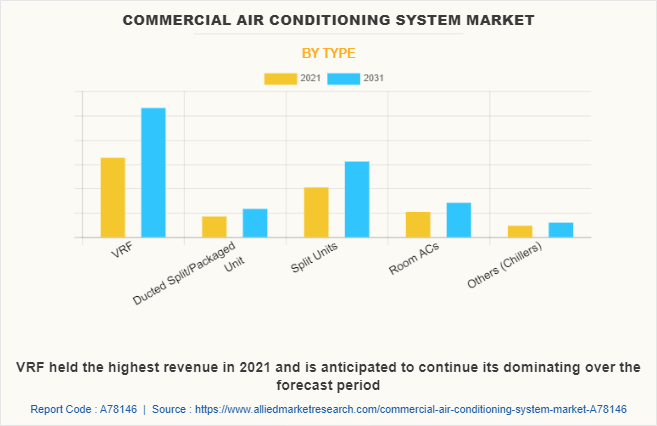
By type, the VRF sub-segment dominated the market in 2021. In comparison to conventional systems, VRF systems significantly reduce their energy consumption by using inverter-driven compressors that can change their speed to fit the cooling or heating demand of each specific room. In order to increase occupant comfort and cut down on energy waste, VRF systems may be made to give individual temperature control for each room or zone in a building. VRF systems may be implemented in new construction projects as well as retrofit situations, and they can be set up to accommodate a variety of building sizes and designs. These are predicted to be the major factors affecting the commercial air conditioning system market size during the forecast period too.
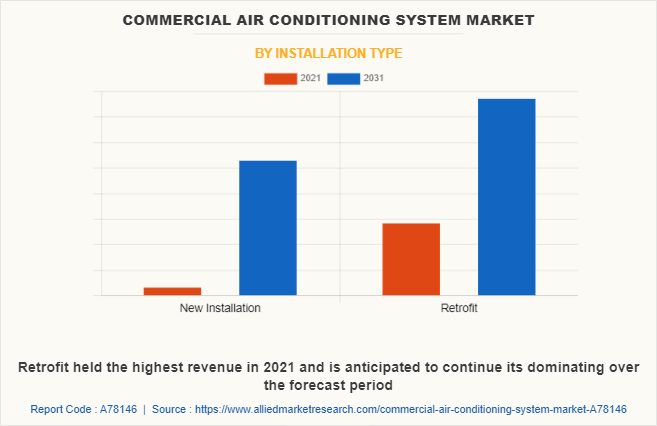
By installation type, the retrofit sub-segment dominated the global commercial air conditioning system market share in 2021. The market for commercial air conditioning systems is being retrofitted with new and better technology largely to decrease energy consumption, cut operating costs, and lengthen system life. The efficiency and environmental effect of an old air conditioning system can be increased by retrofitting it with modern technology. To operate commercial air conditioning systems after retrofitting, additional rules or requirements must be followed. For instance, the amount of energy that air conditioning systems may consume is now subject to tougher limits in many countries, and retrofitting is frequently needed to comply with these rules.
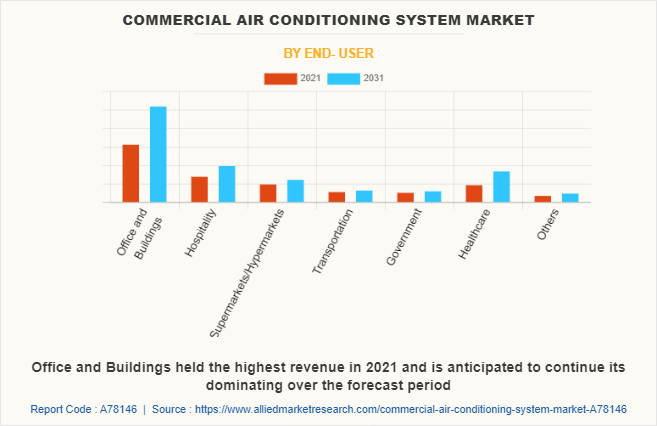
By end-user, the office and buildings sub-segment dominated the global commercial air conditioning system market share in 2021. There is a rising demand for energy-efficient and environmentally friendly air conditioning systems in the office and building segment of the commercial air conditioning system market. Building owners and facility managers are increasingly seeking HVAC systems that may help them lower their energy usage and carbon footprint as the focus on sustainability grows. Other factors driving the demand for the sub-segment include better control over and management of temperature and humidity levels, improved indoor air quality, and the requirement for dependable and effective systems that can give workers a comfortable and healthy work environment.
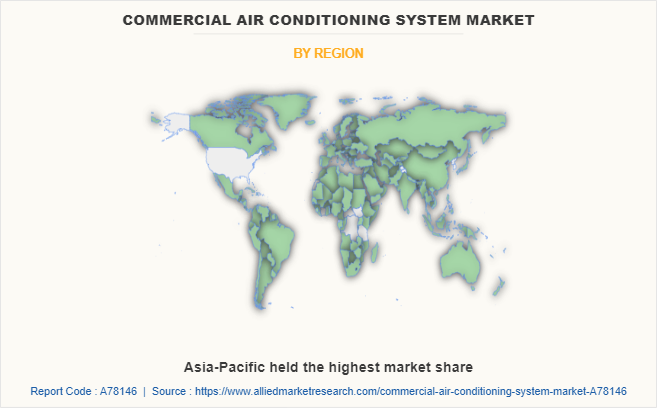
By region, Asia-Pacific dominated the global market in 2021 and is projected to remain the fastest-growing sub-segment during the commercial air conditioning system market forecast period. The Asia-Pacific region is increasingly urbanizing, contributing to a rise in construction activity. Commercial air conditioning systems are now in greater demand in the region as an outcome of this. With a rise in office buildings, shopping centers, and other commercial areas, the commercial sector in the Asia-Pacific region is expanding rapidly. The demand for commercial air conditioning systems is rising as more individuals choose to install air conditioning systems in their homes and workplaces as a result of rising disposable income in the Asia Pacific area. Energy-efficient air conditioning systems are in demand as a result of measures being implemented by governments in the Asia-Pacific region to minimize greenhouse gas emissions.
Impact of COVID-19 on the Global Commercial Air Conditioning System Industry
- The COVID-19 pandemic had a significant impact on the commercial air conditioning system market. Because many companies, offices, and public spaces were temporarily closed or only partially occupied due to the pandemic, there was a decline in the demand for commercial air conditioning equipment. The need for air conditioning systems that can effectively control and prevent the spread of the virus, however, has increased as shops and public spaces started to reopen Additionally, the production of HVAC equipment has been delayed by a lack of workers and problems obtaining materials.
- The pandemic has had a variety of effects on the commercial air conditioning business. Among the biggest impacts has been a decrease in the demand for commercial air conditioning systems because of decreased economic activity and the pandemic-related closure of several businesses.
- The pandemic has also resulted in labor shortages because of travel and movement restrictions, delays in the procurement of raw materials and components, and other supply chain disruptions. Commercial air conditioning system manufacture and delivery have been hampered as a result.
- Economic slowdown has affected the setup of new commercial air conditioning system projects across the world as majority of government fundings were diverted towards healthcare sector owing to rapid spread of the COVID-19 virus, impacting the market to the great extent.
Key Benefits For Stakeholders
- This report provides a quantitative analysis of the market segments, current trends, estimations, and dynamics of the commercial air conditioning system market analysis from 2021 to 2031 to identify the prevailing commercial air conditioning system market opportunities.
- The market research is offered along with information related to key drivers, restraints, and opportunities.
- Porter's five forces analysis highlights the potency of buyers and suppliers to enable stakeholders make profit-oriented business decisions and strengthen their supplier-buyer network.
- In-depth analysis of the commercial air conditioning system market segmentation assists to determine the prevailing market opportunities.
- Major countries in each region are mapped according to their revenue contribution to the global market.
- Market player positioning facilitates benchmarking and provides a clear understanding of the present position of the market players.
- The report includes the analysis of the regional as well as global commercial air conditioning system market trends, key players, market segments, application areas, and commercial air conditioning system market growth strategies.
Commercial Air Conditioning System Market Report Highlights
| Aspects | Details |
| Market Size By 2031 | USD 57.9 billion |
| Growth Rate | CAGR of 4.5% |
| Forecast period | 2021 - 2031 |
| Report Pages | 300 |
| By Installation Type |
|
| By End- User |
|
| By Type |
|
| By Region |
|
| Key Market Players | Panasonic Corporation, fujitsu general, Mitsubishi Electric Corporation, Voltas, Inc., LG Electronics, Haier Inc., Blue Star Limited, Carrier, Hitachi, Ltd., Daikin Industries, Ltd. |
The diverse energy-efficient air conditioning systems are becoming more popular as businesses look for ways to reduce their energy costs and carbon footprint. As a result, there is a growing market for high-efficiency systems that can save energy and reduce costs, which is estimated to generate excellent opportunities in the commercial air conditioning system market.
The major growth strategies adopted by commercial air conditioning system market players are investment and agreement.
Asia-Pacific will provide more business opportunities for the global commercial air conditioning system market in future.
Carrier.; DAIKIN INDUSTRIES, Ltd; FUJITSU GENERAL; Haier Inc; Hitachi, Ltd.; LG Electronics.; Mitsubishi Electric Corporation; Panasonic Corporation; SAMSUNG; and AIREDALE INTERNATIONAL AIR CONDITIONING LTD are the major players in the commercial air conditioning system market.
Office and buildings sub-segment of the end-user acquired the maximum share of the global commercial air conditioning system market in 2021.
Office and buildings are the major the major customers in the global commercial air conditioning system market.
The report provides an extensive qualitative and quantitative analysis of the current trends and future estimations of the global commercial air conditioning system market from 2021 to 2031 to determine the prevailing opportunities.
Rapid advancements in technology have led to the development of more sophisticated and efficient air conditioning systems. Companies that invest in research and development can capitalize on this opportunity by creating innovative products that offer improved performance and energy efficiency.
Loading Table Of Content...
Loading Research Methodology...



